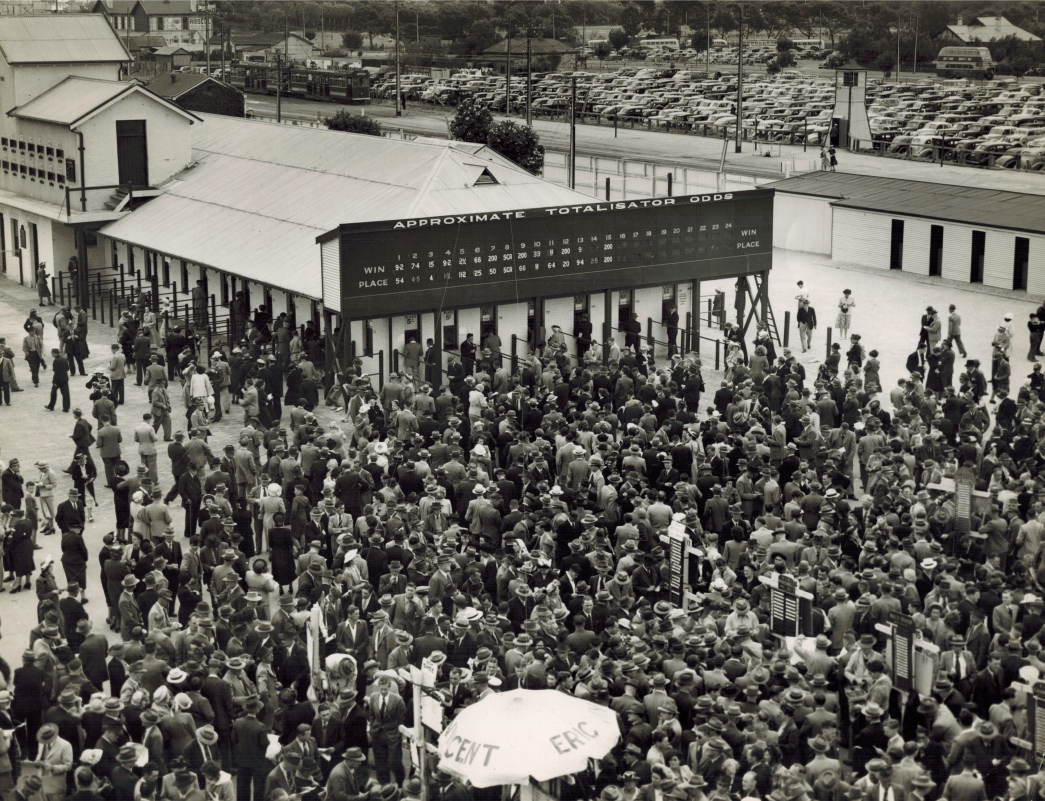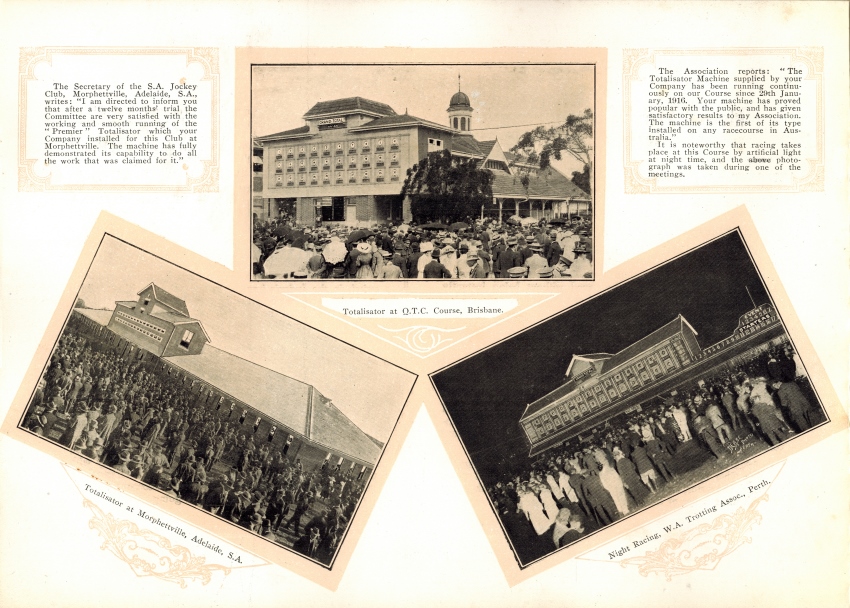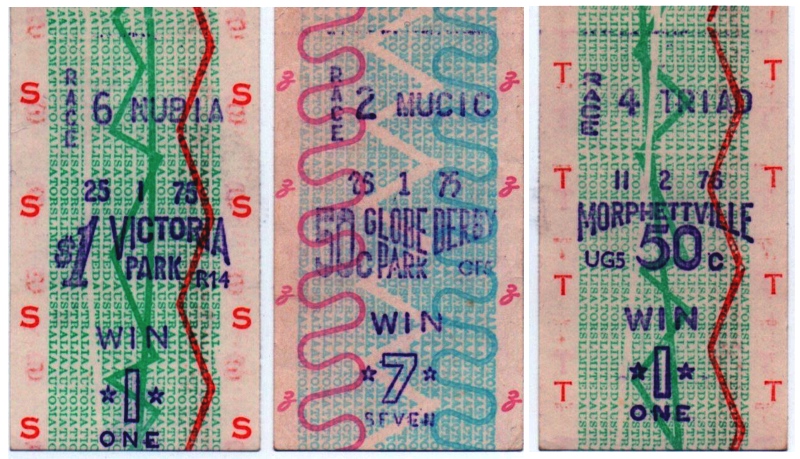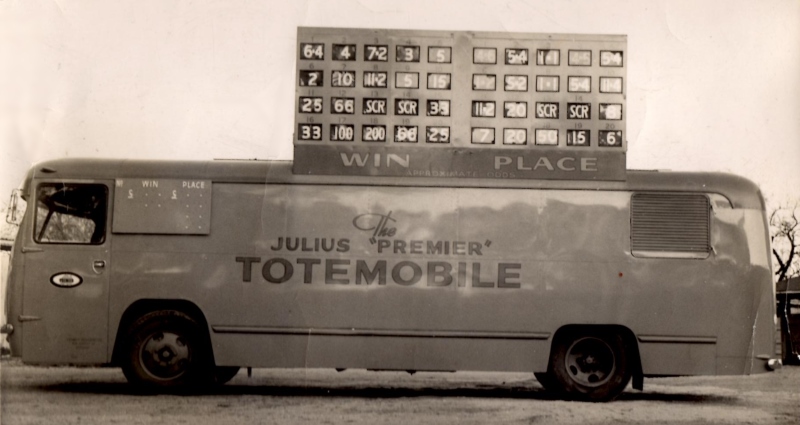
Click on the image to go back to the Photo Gallery
The photographers stamp: "Photography as you like it" - Howard R. Boase PHOTO - 31 Naldera St. - GLANDORE
The image below shows the Main Tote House and Betting Ring at the South Australian Jockey Club's Morphettville Racecourse. The original Julius Tote installation was performed here in 1921 with 34 terminals and a second Julius Tote Installation was performed in 1926 adding another 30 terminals. These were the 13th and the 23rd installations performed by Automatic Totalisators Limited, later known as ATL.
On the first floor of the Main Tote House, at the far left of the image, is the Julius Tote Machine Room. On the side of this machine room, two rows of seven boxlike windows are visible. These are the right hand part of the Julius Tote Runner Investment Indicator presumably showing the Win Pool. Each window contains a Drum Counter Wheel display showing the total investment on a particular runner for the associated pool. The top row of runner investment windows are labeled 9 through 15 and the bottow row 24 through 30.
The Blind type Odds Indicator on the right hand end of this building, with the sign Approximate Totalisator Odds on top, is a later Automatic Totalisators Limited product showing both Win and Place pool odds rather than runner investments. As can be seen from this more modern indicator, the field sizes have reduced since the original installation, with the older Investment Indicator supporting a maximum field size of 30 and the newer Odds Indicator supporting a maximum of 24 runners. I think this photograph was probably taken in the 1950s. The Julius Tote was still in operation then and would continue till 1975 when it was replaced with an Automatic Totalisators Limited computer totalisator. This computer tote installation was performed two years prior to my joining the company to work on the computer systems that would replace the Queensland Julius Totes.
By the looks of the ladder leaning up against the right hand side of the Odds Indicator, it seems that there might be a problem with the indicator requiring some attention. More after the image...

This photograph had no description with it. The photographer's stamp indicates their office is in Glandore which is a suburb of Adelaide. I have been to Morphettville Racecourse once and been on the Glenelg tram, which runs past Morphettville Racecourse, several times and suspected this photograph was taken there, however I needed to confirm this. Lyn Roberts, Executive Assistant at the South Australian Jockey Club was very helpful, taking the query to the Chief Executive Officer Brenton Wilkinson who confirmed this photograph is Morphettville and taken at the back of the Derby grandstand. Lyn also wrote the following on 2nd June 2014:
The shed on the right hand side was the ticket entrance facility adjacent the tram line (trams still travel from Adelaide to nearby Glenelg and we have our own stop on race days for patrons). Brenton cannot definitely date the photograph but feels 1950's would be correct.Lyn's mention of the Ticket Entrance Facility above revived a distant memory of mine. ATL had a turnstile product which was very popular. They were present at every one of our racetracks in Brisbane when I started working there. I am almost certain that these turnstiles would have been in use in the entrance facility at Morphettville that Lyn mentions. These turnstiles were not only used by racetrack customers but any business that had an interest in counting the number of customers entering their grounds. I spent decades travelling Australia by light aircraft and was amazed at the obscure far flung places these turnstiles kept appearing. There is a short segment on these turnstiles in this website titled Norm Noble Minister for Turnstyles in the Memories of the final factory chapter of this website, in the Secondly section of the index. To read this, click on the image above, scroll down to the bottom of the page and select the Go to the index button in the Navigation Bar and select the chapter mentioned and scroll down to the title mentioned.
I noticed that the 1921 Julius Tote installation performed at Morphettville is recorded on the SAJC (South Australian Jockey Club) website. When I wrote to Lyn about this, she replied with the following information regarding this history document:
The one to which you refer would have been written by Frank Keen who joined the Club as Assistant Secretary in 1954 and was appointed Secretary in 1964. He retired following the Royal Visit in October 1981 and died about two years ago. I have attached a three page extract from this history relating to Totalisators which may be of interest to you. Your website is amazing!!
Following are some extracts from Frank Keen's South Australian Jockey Club history document, which Lyn provided and I found particularly interesting:
A significant advance in accommodation and service was achieved when in 1921 a new brick building was erected to house the new Julius totalisator.In those early days it was not uncommon to have two different totalisator operations on the one day with a five shilling tote in the grandstand and a two shillings and sixpence tote in the Derby and on the Flat, with each being separate pools and declaring separate dividends.
In the immediate post World war II era, a hotchpot of totalisator systems evolved. Automatic Totalisators Ltd (ATL) conducted an electro-mechanical system for win and place betting on Adelaide races, this was the most efficient system then available but it required capital expenditure on ticket issue machines and costly installation and maintenance of multi-core cables from each selling enclosure to the central control room. Bertram Totalisators operated a manual box issue system of pre-printed tickets for interstate win and place betting and all quinella and trifecta betting. The main objections to this system was the doubtful security, delay in declaring dividends and the patrons dislike of pre-printed and coded tickets.
Quinella betting was introduced at Morphettville in 1958.
Women were first authorised by Government Legislation to work in Totalisators in November 1963.
The manual totalisator system was dispensed with in December 1967 when the Committee accepted a tender from ATL to install and operate machine betting for all pools.
Totalisator betting on Sydney races was introduced in 1969.
A closed circuit television (black and white) of totalisator odds was installed in the grandstand and members enclosure in 1970. The system was later extended to the Derby and Flat.
I find the above extracts interesting as they highlight the fact that totalisators did not suddenly spring up with the functionality we know today but developed over a long period of time. Additionally, I find the reference to women first authorised to work on totalisators in 1963 curious, as in 1977 when I started work on the computer side of totalisator systems most of the sellers were women.
In parallel with my communicating with the SAJC, Neville Mitchell, the best ATL historian I know, queried the image above with his friend Malcolm Smith, an ex Detective in South Australia. Malcolm provided the following information on the Morphettville Racecourse image above.
Yes, I think I can say with a positive degree of certainty it is Morphettville, located within the boundary of Anzac Highway, Morphett Road, Bray Street and others. So, how many points of reference can I find. The photo is taken from inside the Course looking approximately north/west. Glenelg is to the left, Adelaide to the right. I think the building in the foreground is still there. I forget what it looks like from the Course side, but from the tram side it seems familiar, but I haven't travelled on the tram for some time or endeavoured to take detailed notice of the building architecture. I can see two trams beyond the building, where the Adelaide-Glenelg tramline is. They appear to be 'drop-centre' type and we had those. A pity they are not the famous 'H' class, all closed in. The car park is still there. Further on, there is a double decker bus (not electric trolley) and that would be on Anzac Highway heading towards the city. In the angle north/west I can see a vacant area between the trees and that would be Camden Oval on the corner of Anzac Highway and Morphett Road and it is still there. Glandore is a suburb towards the city. I have only been to the races there a couple of times, both on duty, and I remember 'turfing' someone off the Course and I think there was a police room in the low-level building to the right.
Since ascertaining in 2014 that the image above shows Morphettville Racecourse, I have found in October 2017 that page ten of an Automatic Totalisators Limited booklet titled Straight Betting contains a photograph of this tote house, shown bottom left in the image below. This confirms what has already been ascertained, the image above indeed shows Morphettville Racecourse.
Page 10 Straight Betting

The image above shows page ten extracted from the company booklet Straight Betting. The bottom left image in page ten above, shows the tote house containing the 1921 Julius Totalisator at Morphettville installed for the South Australian Jockey Club. It also shows the crowds that attended meetings in those days. The latest year that I have seen mentioned in Straight Betting is 1922. This probably is the year this booklet was produced and if not, probably soon after. The image above, as well as the rest of the Straight Betting booklet, is a historic example of artistic company product promotion in the early 1920s. Low image resolution was probably normal back then.
It is interesting to compare and contrast the image of the tote house at Morphettville in page ten of Straight Betting above, with the image of a photograph taken much later, shown at the top of this page. The little A shaped vent protruding from the roof near the apex of the right hand end roof section, which is visible in the image above, is still there in the image at the top of the page. Obviously the Odds Indicator above the windows in the right hand end of this Main Tote House building, is a new addition as seen in the image at the top of this page only. Two or three more windows have been added in the right hand wall of the tote house, taking the number from four visible in the image above to seven total in the image at the top of this page. Another obvious addition is associated with the first floor section containing the investments indicator. The window in the right hand end of this first floor section visible in the image above, has been converted to a door in the image at the top of the page, which has three steps down to a platform allowing outside access to the investment indicator display counters. The platform runs along the front of the investment indicator. Finally the queueing rails in front of the tote house windows are a new addition seen in the image at the top of this page.
Thanks to Bruce Rutter, who held multiple management positions with Automatic Totalisators Limited finally becoming General Manager, for giving me his copy of Straight Betting. Although this booklet is elegant with an ornate cover, it seems to be a pre release version of it. There is fountain pen writing on the front cover which reads Mr Raymonas with memos inside written below. Inside the booklet, the text has deletions and additions marked, some in pencil and others in fountain pen. An example can be seen in the Page 10 image above, inside the top right text box, where the word above in the second paragraph has been marked for deletion from the words the above photograph, as it actually refers to the photo below the text box.
Arthur V Kewney, the Secretary of the S.A. Jockey Club, Morphettville, Adelaide, S.A., wrote the following testimonial to Automatic Totalisator Limited in 1922 relating to the Morphettville Julius Tote in operation inside the tote house shown bottom left in the Page 10 Straight Betting image above:
I am directed to inform you that after a twelve months' trial the Committee are very satisfied with the working and the smooth running of the "Premier" Totalisator which your Company installed for this Club at Morphettville. The machine has fully demonstrated its capability to do all the work that was claimed for it.The first paragraph of Arthur V Kewney's commendation above, can be seen in the top left text box in the Page 10 Straight Betting image above.On Adelaide Cup Day the second time it was in use, the machine handled 36,668 pounds, and on the Cup itself 7,213 pounds 5 shillings was invested, both records for any one machine operating in this state. Since the installation of the Premier Totalisator in May 1921, 13 race meetings have been held at Morphettville and 253,123 pounds 10 shillings has passed through the machine.
The following ticket images were provided by Chris Robertson, the most totalisator industry knowledgeable high value punter I have ever met. The right hand ticket was produced by the Julius tote inside the tote house in the image at the top of this page. Although I have flown to Parafield airfield in light aircraft, I never managed to visit Globe Derby Park which is on the western side of the airport across the Salisbury Highway where the middle ticket below was produced. I have been to Victoria Park a few times but never to a race meeting, it always looked more like a public park than a racecourse. I did see a Victoria Park Grandstand entrance, which might have been part of the racecourse infrastructure. The Clipsal 500 straight now runs through this park. The left hand ticket below was produced at Victoria Park.
Chris Robertson's Adelaide Tickets
Chris Robertson wrote the following about the group of tickets to which the above tickets belonged:
ATL ticket selling operations were largely similar between states in the mid 1970's, with Melbourne being somewhat more advanced having computerised trifecta/trio J18 ticket issuing machines. For that reason I have saved only one machine issued ticket from each racecourse I visited in South Australia and Queensland. The tickets are all J8, with the exception of the Albion Park ticket which is from an earlier machine.Chris made the following comparisons with South Australia:
I kept more of the hand-written tickets sold by ATL at Adelaide racecourses because they are more interesting. In Victoria the sale of Daily Doubles and Quadrellas on course was a manual TAB operation, which meant selling closed twenty-five minutes prior to the first leg to allow time for collation and transmission of betting totals to head office. South Australian racegoers were in the fortunate position of having the on-course tote carry out the sale of Daily Doubles, Trebles and Fourtrellas (the S.A name for the Quadrella) right up to the jump.The following image of manual tote tickets from Chris Robertson demonstrates an interesting point. When you don't have automatic totalisator machinery you have to conduct a manual tote. The following tickets were produced and recorded manually by Automatic Totalisators limited staff as the tote machinery at the time did not support the Daily Double and Treble pools.
 Chris Robertson's Adelaide Manual Tickets
Chris Robertson's Adelaide Manual Tickets
Chris wrote the following about the above manual tickets:
Apart from a difference in closing times, the ATL Adelaide operation was very similar to the Victorian TAB on-course. Both used double sided carbon paper as an extra security measure to dissuade would be forgers from adding units or altering a number. I have included a scan of both sides of the ATL written tickets. If you flip horizontally the rear of the tickets you get an almost exact duplicate of the front of the ticket. The reason for this added security is that in both states winning tickets were usually cashed without matching the original with the duplicate. This was done to save time. Of course larger dividends, as well as tickets with double-digit units, were matched with the duplicate before payout. So were tickets from other days.In the last paragraph, Chris mentions something historically interesting from a technical standpoint, approximate odds being manually updated on television displays. There is another page in the Photo Gallery of this website that shows how this was achieved. To read this, click on the image at the top of this page and scroll down the photo gallery index to the Miscellaneous Images section and continue to scroll to and select the image icon with associated text starting A bygone dividends and odds TV display method.One difference is the use of an 'x' on the South Australian tickets to signify one unit. This made it even less likely that anyone would be tempted to add a zero. Interestingly the South Australian TAB did the same thing off-course. Another difference is that there is a place on the ATL ticket to add the dollar value of a 'Field' bet. In Victoria such a bet would have required filling in a separate multiple ticket - a much more laborious process.
Win and Place odds indicators in Adelaide were rudimentary. TV monitors showed the approximate odds, with the odds being changed manually, and at irregular intervals. It should be remembered that betting volumes in South Australia on Saturday metropolitan meetings would have been roughly equivalent to provincial mid-week in Victoria, and for the most part there was little sophistication in odds display at the latter in the mid 1970's.
Following are some memories from Rod Richards written in January 2017. Rod was an Automatic Totalisators Limited engineer, who worked on the Julius Totalisators and remembers, as an apprentice, assisting with driving one of these Totemobiles from the Meadowbank factory to Adelaide, as well as getting it started on the rounds. The TIM Rod mentions is a Ticket Issuing Machine:
I first got my driving licence in Adelaide, in order to drive the Totemobile legally; I did drive the Totemobile part of the way from the Factory to Adelaide under instruction. To get your licence then, all you had to do was answer 14 questions out of the Drivers Hand Book and you got your full licence, no driving test was required. In those days, in Adelaide (1950) you had to have a licence to learn to drive and with that licence you could legally drive any motor vehicle except an Omnibus and other special vehicles - cars, trucks, motor bikes etc were all OK on the same licence - times have changed.
Webmaster's comment:
It's a long drive from Sydney to Adelaide! It is interesting to note that Rod having to sit his first driving test at 85, triggered the above recollection. This driving test is mandatory for anyone wishing to continue to drive in Australia, on reaching the age of 85.
The Totemobile Rod drove to Adelaide

Rummaging through a lot of family photo's I came across the photo of the Totemobile we built up at Meadowbank and drove to Adelaide. The photo was taken by the Adelaide Advertiser Newspaper on 30th July 1952, after we arrived from Sydney. The Advertiser was interested as it was at the time, quite unique to have such a vehicle to operate the mid-week country races.
The Totemobile was fitted out using an Ansair Bus, part of the Reg Anset Transport group, I think. The bus was fitted out with adders and the operating system as a fixture, the power supply was by two Ford 10 engines driving 120 volt DC generators; one being a backup; the power supply was enclosed at the back of the bus.
We carried a number of J8 TIM (10?) to locate in the pre-existing selling houses at each racecourse. The indicators, 10 banks of 4, which were also carried in the bus, were raised through the opening in the roof of the bus, after the display board was raised from the roof of the bus and fixed in place. After the indicators were set up and working, the whole arrangement was covered by a canvas cover over a frame work.
There was usually a crew of 3 on race day, which was rather a long day; to drive to the race track, the distance varied as there was a number of tracks spread around SA. Set up and run tests then after the last race, pack up the bus and drive home again.
From memory we operated at - Tailem Bend, Murray Bridge, Gawler, Claire, Kapunda, Balaklava, Port Pirie and Port Augusta. At Port Augusta it was an annual meeting of two or three days duration.
One incident at Balaklava caused quite an upset, as during the early part of the meeting, things started going wrong with the betting on the Tote, as it turned out the Win and Place cables, which had the same type of plugs, were connected to the selling house reversed; the Win cable was connected to the Place side and the Place cable connected to the Win side. It was not immediately apparent what the problem was, so the Tote was shut down and a manual system operated for the rest of the meeting. As a result when the problem was discovered, the plugs were altered for the next meeting, so that the this could not occur again.
In January 2019, Rod Richards added the following: When I was based in Adelaide (1952-55) race meetings were held mainly at Victoria Park racecourse on the outskirts of the city, with a number of meetings held at Morphettville racecourse. Both these racecourses shared the J8 Issuers which were boxed and transported to each racecourse between meetings. Our job was to pack and unpack the issuers in the metal carry boxes, install them and run tests - I can believe that they weighed 85lbs, as Joe Brandon mentions in his article on the J8.
There is another page in the second page of the Photo Gallery of this website that relates to the J8 TIM, which includes Joe Brandon's article on the J8 that Rod mentions, as well as a following technical description. To read this, click on the image at the top of this page and scroll down to the bottom of that page and select the Next page in the navigation bar at the bottom. Scroll down again in the photo gallery index to the heading Ticket Issuing Machines (TIMs) then scroll down a little further and select the image with the associated text that starts with The J8. This TIM could be called iconic or famous.
It seems that within Automatic Totalisators Limited, that the names of the Australian State Branch Managers and Chief Engineers were icons. Most staff I met knew the names even if they had not met them. The last names I remember from South Australia were Peter Hall the Branch Manager and Jan Potocke Chief Engineer.
One final comment, nothing to do with totalisators, just a historic observation in the image at the top of this page. The nearest of the two tall buildings outside the racetrack at the top of the image near the left hand side, has an advertisement on it. This is visible in a higher resolution copy of this image. It reads AMSCOL Ice Cream. The Baby Boomer generation of Adelaide have fond memories of this ice cream treat. AMSCOL stands for Adelaide Milk Supply CoOperative Limited.